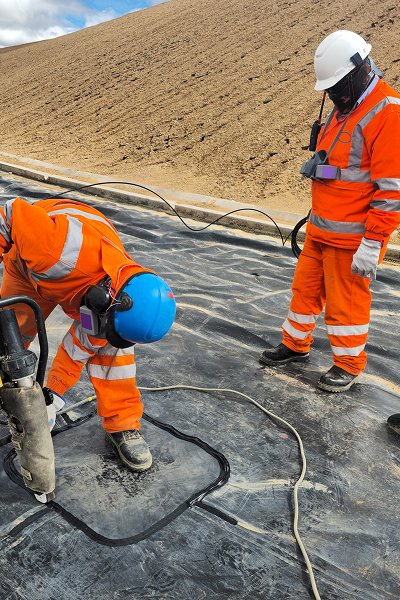Geotube Structure
Geotube are giant cylindrical or flat, long bags made of high-strength, corrosion-resistant synthetic fiber geotextile.
Material: Woven geotextile or woven geotextile fabric are commonly used. Some models feature an outer coating (such as PVC) to enhance UV and abrasion resistance.
Size: Diameters range from 1 to 5 meters, and lengths can reach tens or even hundreds of meters, customizable depending on project needs.
Structure: The bag is constructed from two or more sewn geotextile sheets, offering excellent water permeability and tensile strength.
Geotube form a water-retaining structure through two processes: filling and consolidation.
Filling Process
The Geotube is laid flat on the foundation. A high-lift pump injects water containing sand or slurry into the bag.
Water is discharged through the micropores of the geotextile, while solid particles (sand, silt, etc.) are trapped within the bag.
Consolidation Process
As the water is discharged, the filling material within the bag gradually settles and densifies, resulting in a highly stable bag.
The weight of the filling material and the friction of the bag form a single gravity dam structure that can withstand water impact and surge pressure.
Stability and Seepage Control
The bag itself is a flexible structure that can adapt to certain uneven foundation settlements without overall failure.
In applications such as hydraulic cofferdams and breakwaters, the bags are arranged side by side or stacked to form a continuous retaining wall, reducing seepage.


Traditional cofferdam
Sheet Pile Cofferdam
Structure: Locking steel sheet piles are driven into the riverbed or seabed using a pile driver to form a closed or semi-enclosed structure.
Earth-Rock Cofferdam
Structure: Earth, sand, and gravel are piled up to form a dam shape, sometimes with an impermeable membrane or clay layer.
Concrete Cofferdam
Structure: Concrete walls are cast directly into the water or precast to create an enclosed space.
Geotubes vs. Traditional Cofferdams
| Comparison Item | Geotube Cofferdam | Traditional Cofferdam (Steel Sheet Pile / Earth-Rock) |
|---|---|---|
| Material | High-strength geotextile (PET or PP) + fill material (sand, dredged soil) | Steel sheets / earth, sand, rock / concrete |
| Seepage Control | Good, relies on geotextile structure and fill density | Excellent for steel sheet piles; earth-rock types require additional impermeable lining |
| Structural Form | Flexible structure | Rigid structure |
| Height Capacity | Generally ≤ 6 m (can be stacked for more height) | Can exceed 10 m depending on design |
| Foundation Adaptability | Excellent, suitable for soft foundations without major treatment | Soft foundations often require reinforcement |
| Reusability | Generally single-use | Steel sheet piles reusable; earth-rock not reusable but materials may be recycled |
| Construction Speed | Fast, quick deployment and filling | Slower, requires heavy equipment and more time |
| Wave Energy Response | Absorbs part of the wave energy due to flexibility | Reflects wave energy, may cause turbulence |
Construction Method and Duration Comparison
| Item | Geotube Cofferdam | Traditional Cofferdam (Steel Sheet Pile / Earth-Rock) |
|---|---|---|
| Pre-construction Preparation | Level the foundation → Lay impermeable liner (optional) → Position and marking | Foundation treatment (soft ground reinforcement if needed) → Marking and surveying → Equipment mobilization |
| Main Construction Steps | ① Transport folded geotube to site and place in designed position② Install filling inlets and drainage outlets③ Pump sand slurry/dredged material into the tube using a high-head pump④ Water drains out through geotextile pores, solids settle and consolidate⑤ For higher structures, stack multiple layers | Steel Sheet Pile Cofferdam:① Drive sheet piles into river/sea bed with pile driver② Seal interlocks③ Install internal bracing system④ Pump water out to create dry work areaEarth-Rock Cofferdam:① Transport soil/rock to site② Place and compact in layers③ Add impermeable liner or clay core wall |
| Required Equipment | High-head slurry pumps, optional lifting equipment, small work boats | Pile drivers, cranes, transport trucks, rollers, impermeable liner installation equipment |
| Construction Speed | Rapid deployment, usually a few days to close a section | Steel sheet pile: 1–4 weeks depending on scaleEarth-rock: 2 weeks to 2 months depending on material transport and compaction |
| Foundation Sensitivity | Highly adaptable, can be placed directly on soft ground | Soft ground often requires treatment to ensure stability |
| Noise & Vibration | Low | High noise and vibration from pile driving, may affect nearby structures and aquatic life |
| Impact on Water Flow | Minimal disturbance during deployment | Greater disturbance during pile driving or material placement |
Applications of Geotube Bags
River management and flood control: Rapid deployment during flood or river breach emergency response, using on-site sand filling to form temporary flood barriers.
Coastal erosion prevention: Used as breakwaters or revetments to reduce wave scour in ecologically sensitive areas such as beaches, shorelines, and mangroves.
Port and waterway construction: Used as temporary containment structures to intercept water and sediment during port expansion or waterway dredging.
Reservoir and wetland projects: Used to isolate work areas for silt removal, ecological restoration, or artificial island construction.
Sludge and sludge treatment: Used as dewatering containers for both storage and drainage, reducing transportation and disposal costs.


Conclusion
Geotubes are flexible structures that rely on the filler material for stability. Construction and Timeframe: Geotubes are fast, require minimal equipment, and are suitable for soft foundations. They are not suitable for conditions with extremely high water levels or high water pressures. Geotubes are economical and sustainable, offering minimal disturbance and noise, making them suitable for ecologically sensitive areas.


